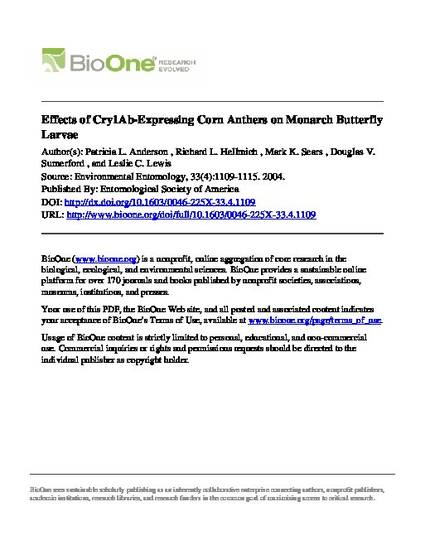
Previous studies suggest that exposure to corn, Zea mays L., anthers expressing Bacillus thuringiensis (Bt)-derived protein may have adverse effects on the larvae of monarch butterfly, Danaus plexippus (L.). To examine the potential effects of Bt anthers on monarch butterflies, studies were designed to test toxicity in the laboratory; examine anther distribution in space and time; compare distributions of anthers, pollen, and larval feeding; and measure effects of long-term exposure in the field. In the laboratory, monarch butterfly larvae fed on whole corn anthers, but anther feeding was sporadic. Larvae exposed to 0.3 anther/cm2 fed and weighed less after 4 d compared with larvae exposed to non-Bt anthers. Adverse effects increased with increasing anther density. Monarch butterfly larvae exposed to 0.9 anther/cm2had reduced feeding, weight, and survival and increased developmental time compared with larvae exposed to non-Bt anthers. Later instars were more tolerant of Bt toxin. For all studies, laboratory testing probably magnified effects because larvae were confined to petri dishes. Field studies showed toxic anther densities are uncommon on milkweed (Asclepias) leaves in and near cornfields during anthesis. Mean anther densities on milkweed leaves in cornfields during peak anthesis were between 0.06 and 0.1 anther/cm2 (≈ 3–5 anthers per leaf). When exposure to a density of five anthers per leaf was tested in field-cage studies, no effects on growth, development, or survival were detected. Based on probability of exposure to toxic densities, Bt anthers alone are not likely to pose a significant risk to monarch butterflies in Iowa.
Available at: http://works.bepress.com/richard_hellmich/49/

This article is from Environmental Entomology; 33 (2004); 1109-1115; doi: 10.1603/0046-225X-33.4.1109